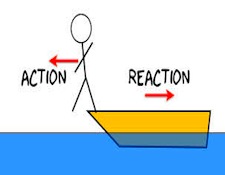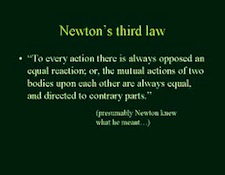It’s the time of year for saving money!
Do you know why speakers have spike mounts instead of more “furniture-style” feet? And do you know why you want to use them? While developed primarily for use on carpeted floors, Many audiophiles even use spikes on hardwood floors that might be damaged if not protected from the spikes.
 It all has to do with Newton’s Third Law of Motion: “For every action there is an equal and opposite reaction”. What this translates to, as applied to speakers, is that the force that tries to move the cone of your speaker forward is balanced exactly by an equal force trying to move the rest of the speaker system backwards.
It all has to do with Newton’s Third Law of Motion: “For every action there is an equal and opposite reaction”. What this translates to, as applied to speakers, is that the force that tries to move the cone of your speaker forward is balanced exactly by an equal force trying to move the rest of the speaker system backwards.
The forces in both directions – forward and backward – are identical, and their effects are identical too: Meaning that an identical amount of what physicists call “work” will be accomplished, and [WARNING: the following has been grossly simplified for ease of comprehension] equal amounts of mass will have been (potentially) moved equal amounts of distance in the process.
To understand this, let’s use a convenience term that we’ll call “mass-distance” That’s just the amount of “tendency to move” that will be applied to any given amount of mass by any given amount of force, and it will always be exactly proportional to the amount of mass and the amount of force that’s applied to it. For example, 100 units of force applied to 1 unit of mass will always (seek to) cause the mass to move 100 units of “mass-distance”; 200 units of force applied to 2 units of mass will (try to) move the mass the same 100 units of mass-distance; as will 50 units of force applied to ½ unit of mass, and so on. The mass-distance to be moved will always be equal to the amount of force divided by the amount of mass to be moved, and it will always work both ways, meaning that more force applied to the same amount of mass will always, at least theoretically, result in more movement and more mass to be moved by the same amount of force will (again at least theoretically) result in less movement.
 The “at least theoretically” has been added because, although the TENDENCY to move to the stated degree will always be exactly as stated, the actual movement may, (as is the purpose of those spikes on your speakers), be something less.
The “at least theoretically” has been added because, although the TENDENCY to move to the stated degree will always be exactly as stated, the actual movement may, (as is the purpose of those spikes on your speakers), be something less.
Now, to the speakers: If — using example numbers chosen to be easy and indicative, if not necessarily actual for any particular speaker system – we assume that the cone of our speaker’s driver (the “moving element” – the part of our speaker that will move to make our music) weighs 1 ounce (28.375 grams) and that the rest of the speaker system (the “non-moving” element – the non-moving parts of the speaker’s driver, plus the crossover, plus the enclosure, etc.) weighs 200 ounces (12.5 pounds or 5.675 kilos), Newton’s Third Law tells us that the driving signal from the amplifier will produce equal mass-distance of (or at least tendency to) movement from the “moving” and “non-moving” elements of our speaker system, and, if we use the cone as our base for calculation, the cone will move 200 units of mass-distance and the rest of the speaker system will move just 1 unit. Or, using the rest of the system instead of the cone as the base for calculation, the cone will (have a tendency to) move 1/200th of one unit and the rest will (try to) move 1 full unit of mass-distance. Whichever way you calculate it doesn’t really matter; the only thing that’s important is that the RATIOS of (tendency toward) movement are always identical.
So now that that has all has been set out, the question is: What difference does it make? So what if a big movement of the cone in one direction is accompanied by a small movement of everything else in the opposite direction? Especially if the “big” movement is (at the most) just a few millimeters and the small movement is, as in the example, just 1/200th of that?
]]> The key to all of it is in all those qualifiers we hung on our definitions – all of the use of the words “theoretical” or “tendencies”, and all of the statements that the force will “try to” or “seek to” move the various masses. To see what I mean, imagine a situation where, instead of spikes, the speaker were coupled to the floor with frictionless bearings and there was no restriction at all to the reactive motion (the movement equal and opposite to the movement intended) of the speaker system. When a positive signal came from the amplifier, the speaker’s cone would respond to it by moving forward to create a positive pressure wave – the beginning of what we would hear as sound. Being light, the cone would move both quickly and far. The problem is that while it’s trying to do that, the rest of the system will be moving backward, partially canceling the forward motion of the cone. And even worse, because the “non-moving” parts of the speaker system are so much heavier than the cone, they will not only move less distance, but they will also be more subject to inertia, and so will start moving later than the cone does, thus causing not only cancellation of some of the cone’s motion, but also actual time domain distortion!
The key to all of it is in all those qualifiers we hung on our definitions – all of the use of the words “theoretical” or “tendencies”, and all of the statements that the force will “try to” or “seek to” move the various masses. To see what I mean, imagine a situation where, instead of spikes, the speaker were coupled to the floor with frictionless bearings and there was no restriction at all to the reactive motion (the movement equal and opposite to the movement intended) of the speaker system. When a positive signal came from the amplifier, the speaker’s cone would respond to it by moving forward to create a positive pressure wave – the beginning of what we would hear as sound. Being light, the cone would move both quickly and far. The problem is that while it’s trying to do that, the rest of the system will be moving backward, partially canceling the forward motion of the cone. And even worse, because the “non-moving” parts of the speaker system are so much heavier than the cone, they will not only move less distance, but they will also be more subject to inertia, and so will start moving later than the cone does, thus causing not only cancellation of some of the cone’s motion, but also actual time domain distortion!
In the example case, the cone is 1/200th of the mass of the rest of the speaker system. Let’s hold that same mass ratio, but apply it to a 12 inch subwoofer at full cry. Under those circumstances, the cone might be moving as much as a full centimeter (+/- 0.400 inch) forward or back, and each time it did so, the reactive motion (at a ratio of 1 to 200) would be 0.002 inch (0.005mm) in the opposite direction; not very much at all, even at that kind of volume level, but because audio is a matter of very small things, more than sufficient to muddy the bass by messing-up its “attack” time and spoil the “kick” of the kick drum, entirely.
 Spiking the speakers to the floor will effectively block much of, or if done particularly well, even all of the speaker’s reactive motion, and will result in materially “tighter” bass and better perceived transient response. That it works is so thoroughly proven that – even in audio; the hobby known never to either fully accept or fully reject practically ANYTHING, it’s hard to find any kind of speakers with any kind of claim to anything better than average performance that don’t come equipped with spike mounts right from the factory.
Spiking the speakers to the floor will effectively block much of, or if done particularly well, even all of the speaker’s reactive motion, and will result in materially “tighter” bass and better perceived transient response. That it works is so thoroughly proven that – even in audio; the hobby known never to either fully accept or fully reject practically ANYTHING, it’s hard to find any kind of speakers with any kind of claim to anything better than average performance that don’t come equipped with spike mounts right from the factory.
Even so, Steven Stone wrote recently about a product that DE-coupled his subwoofer from the floor (for another purpose entirely) and said that, in his nearfield computer system, decoupling the woofer from the floor produced positive sonic results.
How can that be? Is it possible that Sir Isaac Newton was wrong? Or maybe Steven just likes his subwoofers better de-coupled. Or is it that some “laws” should be broken? What do you think?





